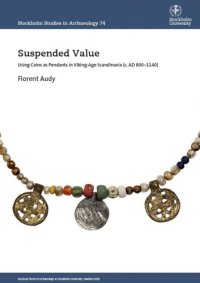
Ebook: Suspended Value: Using Coins as Pendants in Viking-Age Scandinavia (c. AD 800-1140)
Author: Florent Audy
- Genre: History // Archaeology
- Series: Stockholm Studies in Archaeology 74
- Year: 2018
- Publisher: Stockholm University
- Language: English
- pdf
Doctoral Thesis in Archaeology at Stockholm University, Sweden 2018.
The use of coins as pendants is a common practice in the Scandinavian Viking Age (c. AD 800–1140). About three per cent of the coins circulating in Scandinavia show signs of having been adapted for suspension, either with a small hole or a loop. Modifying coins in this way changes the nature of the object. The pierced and looped coins move from having an economic function to having a display and symbolic function, at least temporarily.
After being long neglected by both archaeologists and numismatists, the reuse of coins as pendants has started to receive attention in recent years. This arises mainly from a desire to approach coins from perspectives other than purely economic ones. Coins, like any other archaeological object, are part of material culture. It is therefore also relevant and necessary to investigate their social and cultural significance.
The aim of this thesis is to understand why coins were adapted for suspension and worn as personal ornaments in Viking-Age Scandinavia. Unlike most ornaments of the time, the production of which necessarily involved craft specialists, the Viking-Age coin-pendants could be produced directly by their owners. Their study can thus provide unique insights into how the coins of which they are made, and the messages they carry, were perceived by those using them. What made coins so meaningful that they were often turned into pendants?
The use of coins as pendants is a common practice in the Scandinavian Viking Age (c. AD 800–1140). About three per cent of the coins circulating in Scandinavia show signs of having been adapted for suspension, either with a small hole or a loop. Modifying coins in this way changes the nature of the object. The pierced and looped coins move from having an economic function to having a display and symbolic function, at least temporarily.
After being long neglected by both archaeologists and numismatists, the reuse of coins as pendants has started to receive attention in recent years. This arises mainly from a desire to approach coins from perspectives other than purely economic ones. Coins, like any other archaeological object, are part of material culture. It is therefore also relevant and necessary to investigate their social and cultural significance.
The aim of this thesis is to understand why coins were adapted for suspension and worn as personal ornaments in Viking-Age Scandinavia. Unlike most ornaments of the time, the production of which necessarily involved craft specialists, the Viking-Age coin-pendants could be produced directly by their owners. Their study can thus provide unique insights into how the coins of which they are made, and the messages they carry, were perceived by those using them. What made coins so meaningful that they were often turned into pendants?
Download the book Suspended Value: Using Coins as Pendants in Viking-Age Scandinavia (c. AD 800-1140) for free or read online
Continue reading on any device:

Last viewed books
Related books
{related-news}
Comments (0)